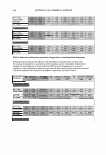338 .. I JOURNAL OF COSMETIC SCIENCE a I " I ti I G 1 I Temperature ( °C) .. " I • I 1 I ' ' Figure 6. The DSC melting curve for AteloHelogen®, showing a melting point determined from the midpoint of the transition at 44.6°C. Table III Melting Temperature Values Determined by DSC for Various Collagens Collagen type Bovine I Bovine III Pig I Pig III Chicken I Chicken III Nile perch (Tilapia sp.) Blue Grenadier (Macruronus sp.) AteloHelogen® Tm pH 2.8 (°C) 42.2 43.5 42.0 43.2 44.7 45.1 35.8 23.0 44.6 Thus, for monomeric cosmetic collagens, the avian collagen, AteloHelogen®, would have a greater stability than the bovine collagens, which may provide significant benefits for formulation and shelf-life stability. Tilapia collagen has been suggested for cosmetic applications, but it has a lower stability than the bovine and particularly the avian collagens. SCANNING ELECTRON MICROSCOPY SEM provides an approach to evaluating any fibrous or particulate material that may be present in a collagen preparation. The samples were dried down onto a clean flat surface for evaluation. In the examples (Figure 7), the AteloHelogen® (panel 1), which presented
COLLAGEN EVALUATION 339 Figure 7. SEM images of thin films of three collagens for cosmetic use: (1) AteloHelogen®, (2) Collasol®, and (3) CLR Collagen®. Scale bars are shown. as a clear solution, showed an essentially featureless film, confirming the lack of par ticulate or fibrous components. On the other hand, the Collasol®, which was a white turbid sample, showed extensive fibrous structures (Figure 7, panel 2). Of interest was the CLR Collagen® sample, which, although presenting as a fairly clear solution, showed a range of black or grey zones under SEM (Figure 7, panel 3). The nature of these spots is not clear. OTHER TECHNIQUES A range of other techniques may also be valuable in assessing collagen for certain applications. These include determination of viscosity and solubility, over a range of pH values to match formulation requirements density refractive index and lipid content. Microbiological content and immunological response may also be issues of concern. CONCLUSIONS The collagen samples examined m the present study show a wide range in various
Purchased for the exclusive use of nofirst nolast (unknown) From: SCC Media Library & Resource Center (library.scconline.org)






































































































